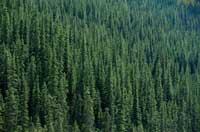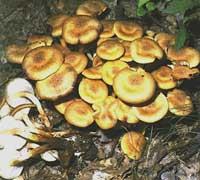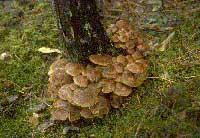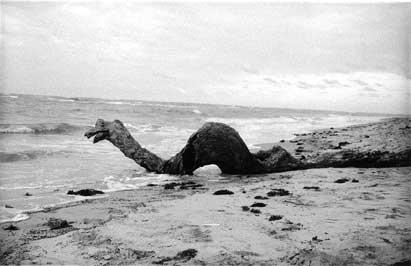Monster under the feet
2001/03/25 Mendiburu, Joana - Elhuyar Zientziaren Komunikazioa

Large and strong killer parasite, but sheltered from the earth's crust, until a few years ago there was no trace of the existence of the fungus Armillaria ostoyae, which lives under the legs. In normal conditions its size is relatively small, but in special cases it can spread disproportionately. Its development is due to a slow but intense extension of filaments and, as is normal, to greater size of the organism, greater need for food. But do not think that hunger will die. No, not before that, it will bind you to the roots of the new trees and absorb all the organic matter.
All the trees surrounding the infectious point suddenly become victims of the fungus. It is enough that by increasing the roots of the tree we put in contact with the filaments of the fungus to be contaminated.

This giant underground fungus secretes from the filaments an enzyme to digest organic matter. The pasarino mushroom does not allow the tree to collect food that enclose its roots and slowly weakens.
To find out if a tree or forest is infected, just make a retreat towards autumn and see if there are yellowish mushrooms at the foot of tree trunks. However, those who do not want to wait until autumn can see if there are white filaments under the skin of the trunk or if the cups have a yellowish, reddish or brownish color.
There is nothing left

This fungus has a sponsor that never fails and helps combat any type of attack. This protector is nothing more than the earth's crust and protects it from both high temperatures and chemical poisons. Therefore, solar rays and forest fires do not kill and chemical treatments are only effective to their extent.
It mainly attacks coniferous species such as pine, fir, larch and cypress. In addition, it seems that young trees are the most dying from the disease. The older ones resist longer, but although the fungi do not kill, they are totally weakened, without forces to combat the attack of strong winds or other pests.
In European and North American forests there are about 40 species of the genus Armillaria. In some cases, the size of this fungus is huge. One of the most famous discoveries of this giant underground fungus, was made in 1992 with Crystal Falls (Michigan). Genetic analysis of fungi found in nearby forests revealed that the fungus (not fungi) was spread over 15 hectares.

A few months later, this discovery was small in Washington State by finding a mushroom spread over 600 hectares. However, the latter is also not accessible for the Guinness book. In 1998, researcher Catherine Parks found the largest known for the moment, with an extension of 900 hectares. They estimate that he is about 2,400 years old and still do not know his weight.
The inhabitants of the area had realized that the trees in the area had some disease, but before performing the genetic analysis, no one would have imagined that it was the only entity!
Difficult solution

Because of his interest in research when the fungus grows dramatically, it is not advisable for all fungi to die from the roots, but the truth is that this invasion does not make much grace to forest guards and wood producers. Unfortunately, its protection does not seem easy to attack the fungus.
First, all the treatments proposed are highly affectionate. Chemical treatments, due to the high number of chemicals to be distributed, are not suitable solutions. On many occasions, there is no other solution than replacing infected trees, introducing as much as possible the species that have the most strength to cope with the fungus.
If the fungus is to be eradicated, it is not enough to cut the trees. You have to lift the entire terrain with excavators to remove the infected roots and put the fungus in the sun. It seems that the fungus dies shortly after removing the protection from the darkness. Of course, if the fungus is spread over hundreds of hectares and submerged three meters deep, it is no easy task. Moreover, the adoption of this rigorous measure does not guarantee that it has definitively disappeared.

On the other hand, it is impossible to think that the epidemic will remain in itself. In fact, dead trees half a century ago still have the capacity to pollute and is a fungus capable of contaminating the subsoil of a whole forest over the centuries. In view of this, it is clear that time is in favor of the fungus.
However, it seems that researchers not only look for the largest fungus to break records. Due to multiple research, in the end it seems that the solution will come from a research team at Purdue University. According to this group, plants may be able to self-defend themselves. To do this, plants must be placed in suitable conditions for the release of a chemical. This substance induces them to kill the fungus cells.
They have not yet realized this idea too much and it remains to be seen in what situation plants should be placed, but if they are able to give a solution before dying more forests.
Published in 7K

Gai honi buruzko eduki gehiago
Elhuyarrek garatutako teknologia






